Analyzing Organizational Culture and Change Management in Business
VerifiedAdded on 2020/03/04
|9
|2176
|244
Essay
AI Summary
This essay provides a comprehensive overview of organizational culture, exploring its definition, importance, and various types. It delves into the role of shared values, beliefs, and assumptions in shaping employee behavior and company performance. The essay examines the impact of resistance to change on businesses, identifying factors that influence organizational culture, such as leadership, nature of business, and external parties. It discusses the four types of organizational culture: clan, adhocracy, market, and hierarchy. Furthermore, it highlights the significance of organizational culture in fostering unity, motivation, and a strong brand image. The essay also addresses the causes of resistance to change, including fear of failure and loss of status, and suggests effective strategies for overcoming this resistance, such as clear communication and employee involvement. Ultimately, the essay emphasizes the importance of a well-developed organizational culture for achieving business goals and objectives.
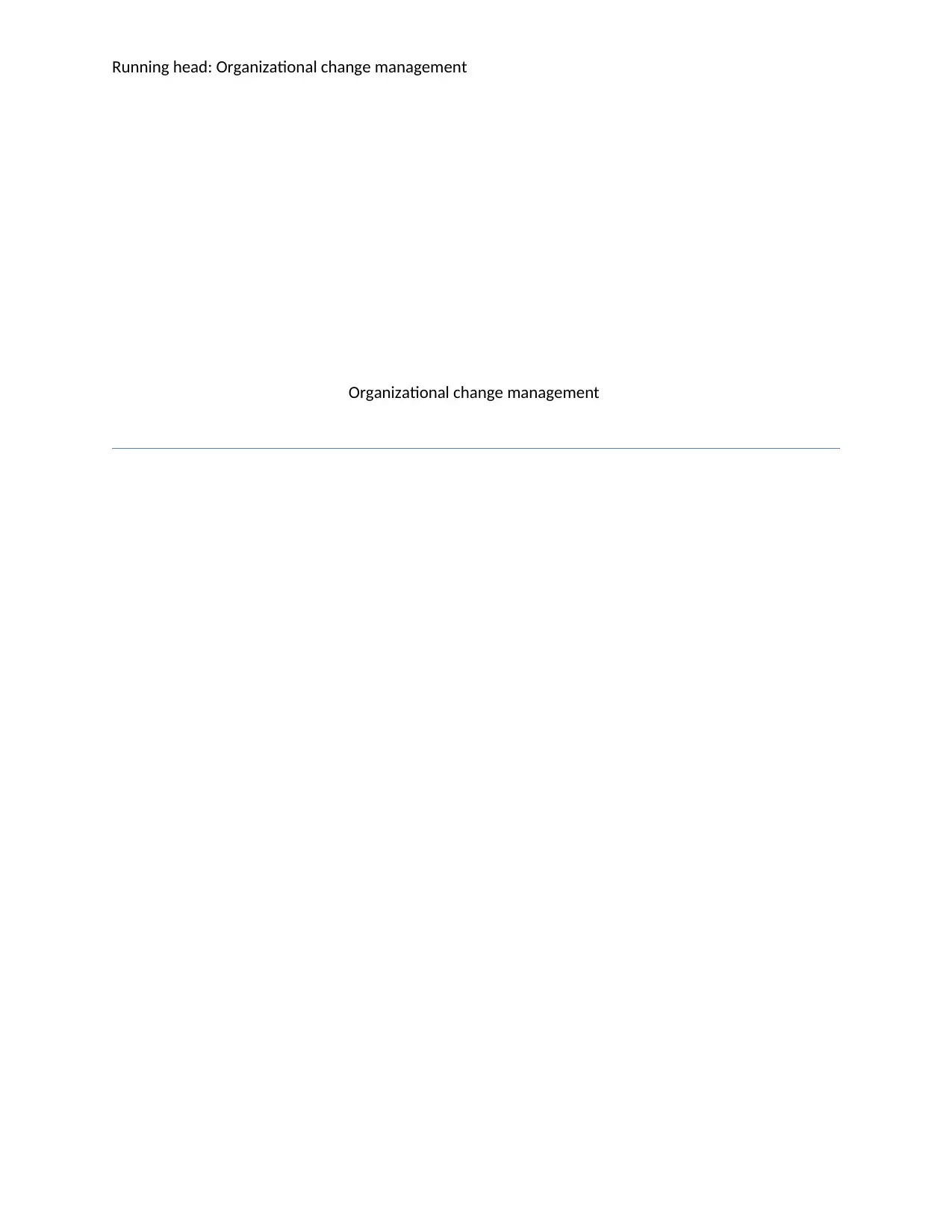
Running head: Organizational change management
Organizational change management
Organizational change management
Paraphrase This Document
Need a fresh take? Get an instant paraphrase of this document with our AI Paraphraser
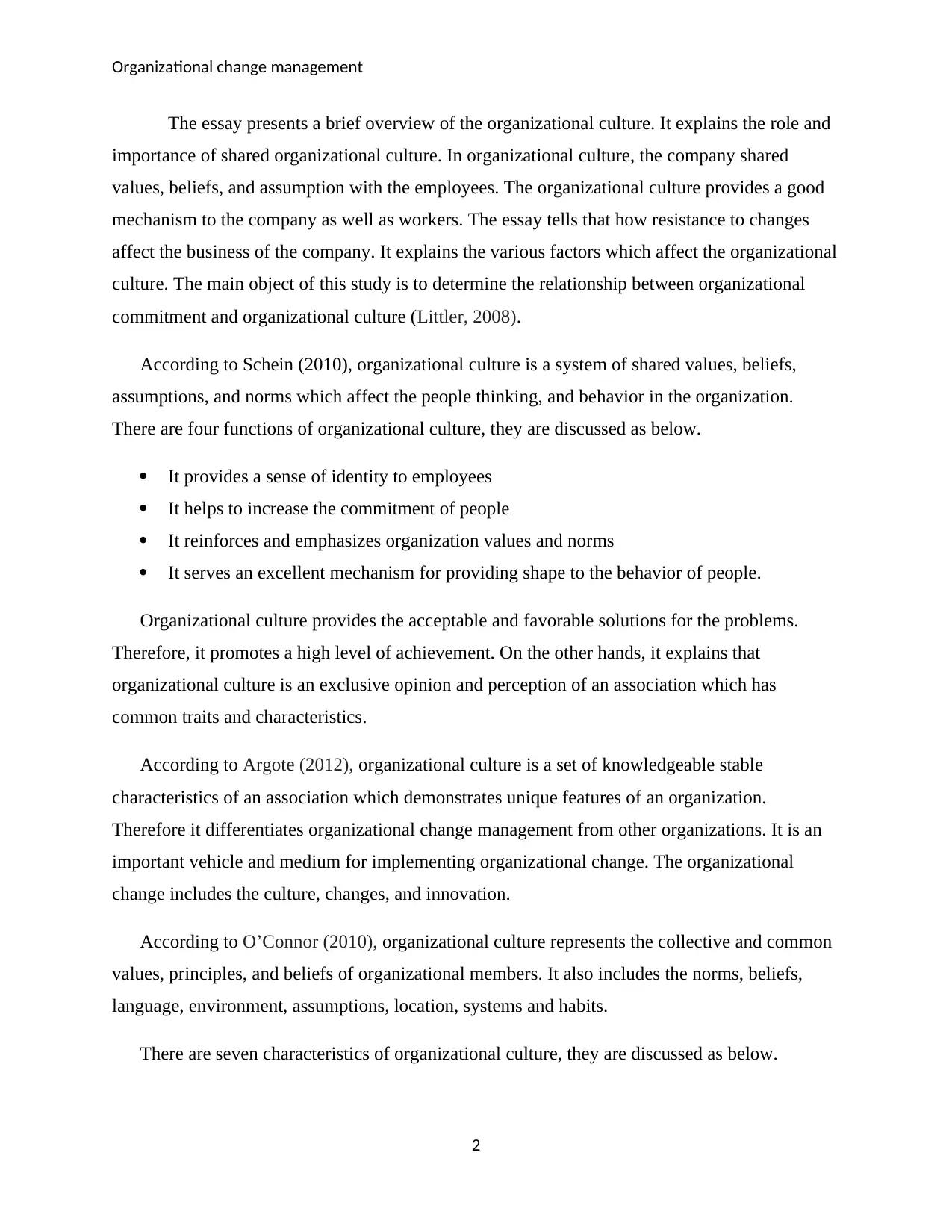
Organizational change management
The essay presents a brief overview of the organizational culture. It explains the role and
importance of shared organizational culture. In organizational culture, the company shared
values, beliefs, and assumption with the employees. The organizational culture provides a good
mechanism to the company as well as workers. The essay tells that how resistance to changes
affect the business of the company. It explains the various factors which affect the organizational
culture. The main object of this study is to determine the relationship between organizational
commitment and organizational culture (Littler, 2008).
According to Schein (2010), organizational culture is a system of shared values, beliefs,
assumptions, and norms which affect the people thinking, and behavior in the organization.
There are four functions of organizational culture, they are discussed as below.
It provides a sense of identity to employees
It helps to increase the commitment of people
It reinforces and emphasizes organization values and norms
It serves an excellent mechanism for providing shape to the behavior of people.
Organizational culture provides the acceptable and favorable solutions for the problems.
Therefore, it promotes a high level of achievement. On the other hands, it explains that
organizational culture is an exclusive opinion and perception of an association which has
common traits and characteristics.
According to Argote (2012), organizational culture is a set of knowledgeable stable
characteristics of an association which demonstrates unique features of an organization.
Therefore it differentiates organizational change management from other organizations. It is an
important vehicle and medium for implementing organizational change. The organizational
change includes the culture, changes, and innovation.
According to O’Connor (2010), organizational culture represents the collective and common
values, principles, and beliefs of organizational members. It also includes the norms, beliefs,
language, environment, assumptions, location, systems and habits.
There are seven characteristics of organizational culture, they are discussed as below.
2
The essay presents a brief overview of the organizational culture. It explains the role and
importance of shared organizational culture. In organizational culture, the company shared
values, beliefs, and assumption with the employees. The organizational culture provides a good
mechanism to the company as well as workers. The essay tells that how resistance to changes
affect the business of the company. It explains the various factors which affect the organizational
culture. The main object of this study is to determine the relationship between organizational
commitment and organizational culture (Littler, 2008).
According to Schein (2010), organizational culture is a system of shared values, beliefs,
assumptions, and norms which affect the people thinking, and behavior in the organization.
There are four functions of organizational culture, they are discussed as below.
It provides a sense of identity to employees
It helps to increase the commitment of people
It reinforces and emphasizes organization values and norms
It serves an excellent mechanism for providing shape to the behavior of people.
Organizational culture provides the acceptable and favorable solutions for the problems.
Therefore, it promotes a high level of achievement. On the other hands, it explains that
organizational culture is an exclusive opinion and perception of an association which has
common traits and characteristics.
According to Argote (2012), organizational culture is a set of knowledgeable stable
characteristics of an association which demonstrates unique features of an organization.
Therefore it differentiates organizational change management from other organizations. It is an
important vehicle and medium for implementing organizational change. The organizational
change includes the culture, changes, and innovation.
According to O’Connor (2010), organizational culture represents the collective and common
values, principles, and beliefs of organizational members. It also includes the norms, beliefs,
language, environment, assumptions, location, systems and habits.
There are seven characteristics of organizational culture, they are discussed as below.
2
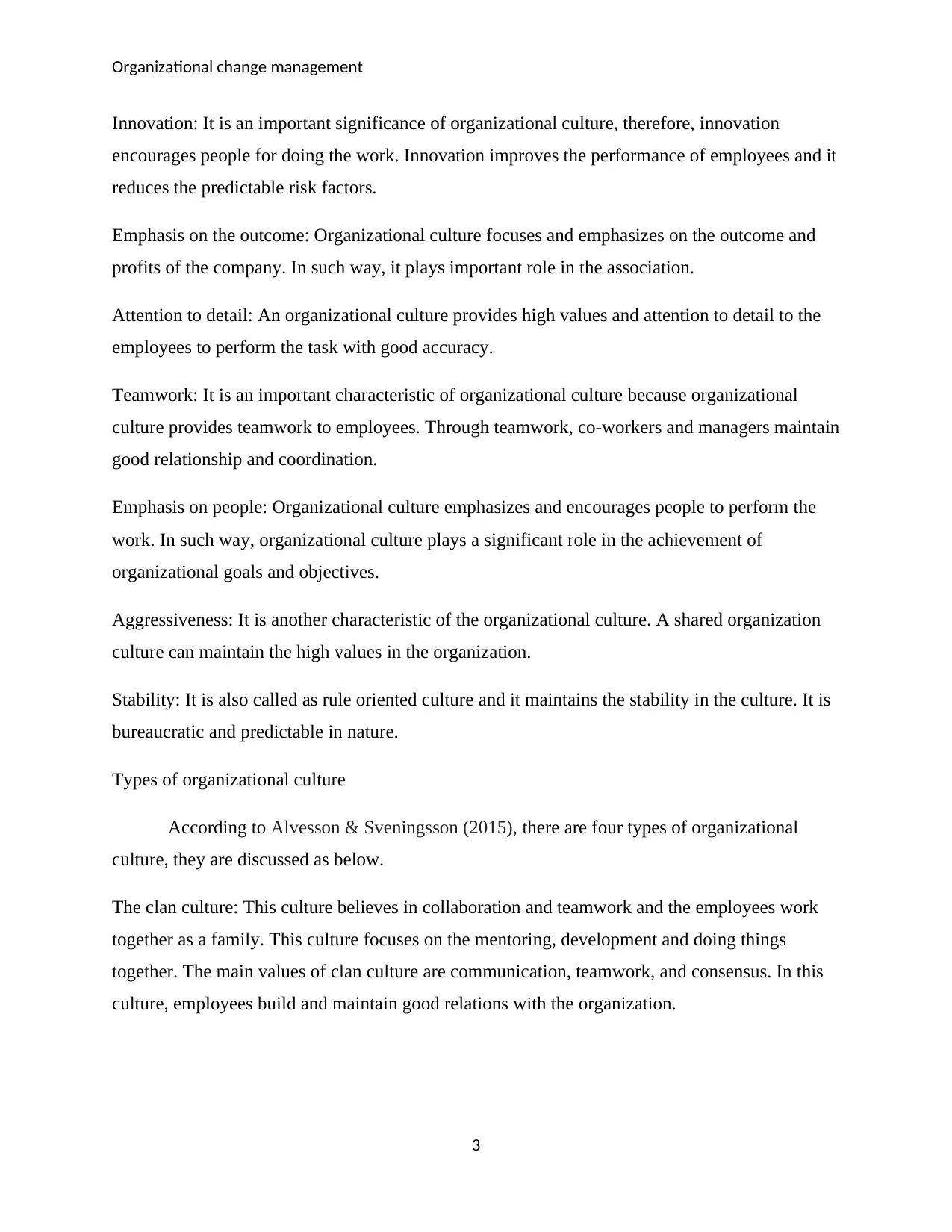
Organizational change management
Innovation: It is an important significance of organizational culture, therefore, innovation
encourages people for doing the work. Innovation improves the performance of employees and it
reduces the predictable risk factors.
Emphasis on the outcome: Organizational culture focuses and emphasizes on the outcome and
profits of the company. In such way, it plays important role in the association.
Attention to detail: An organizational culture provides high values and attention to detail to the
employees to perform the task with good accuracy.
Teamwork: It is an important characteristic of organizational culture because organizational
culture provides teamwork to employees. Through teamwork, co-workers and managers maintain
good relationship and coordination.
Emphasis on people: Organizational culture emphasizes and encourages people to perform the
work. In such way, organizational culture plays a significant role in the achievement of
organizational goals and objectives.
Aggressiveness: It is another characteristic of the organizational culture. A shared organization
culture can maintain the high values in the organization.
Stability: It is also called as rule oriented culture and it maintains the stability in the culture. It is
bureaucratic and predictable in nature.
Types of organizational culture
According to Alvesson & Sveningsson (2015), there are four types of organizational
culture, they are discussed as below.
The clan culture: This culture believes in collaboration and teamwork and the employees work
together as a family. This culture focuses on the mentoring, development and doing things
together. The main values of clan culture are communication, teamwork, and consensus. In this
culture, employees build and maintain good relations with the organization.
3
Innovation: It is an important significance of organizational culture, therefore, innovation
encourages people for doing the work. Innovation improves the performance of employees and it
reduces the predictable risk factors.
Emphasis on the outcome: Organizational culture focuses and emphasizes on the outcome and
profits of the company. In such way, it plays important role in the association.
Attention to detail: An organizational culture provides high values and attention to detail to the
employees to perform the task with good accuracy.
Teamwork: It is an important characteristic of organizational culture because organizational
culture provides teamwork to employees. Through teamwork, co-workers and managers maintain
good relationship and coordination.
Emphasis on people: Organizational culture emphasizes and encourages people to perform the
work. In such way, organizational culture plays a significant role in the achievement of
organizational goals and objectives.
Aggressiveness: It is another characteristic of the organizational culture. A shared organization
culture can maintain the high values in the organization.
Stability: It is also called as rule oriented culture and it maintains the stability in the culture. It is
bureaucratic and predictable in nature.
Types of organizational culture
According to Alvesson & Sveningsson (2015), there are four types of organizational
culture, they are discussed as below.
The clan culture: This culture believes in collaboration and teamwork and the employees work
together as a family. This culture focuses on the mentoring, development and doing things
together. The main values of clan culture are communication, teamwork, and consensus. In this
culture, employees build and maintain good relations with the organization.
3
⊘ This is a preview!⊘
Do you want full access?
Subscribe today to unlock all pages.

Trusted by 1+ million students worldwide
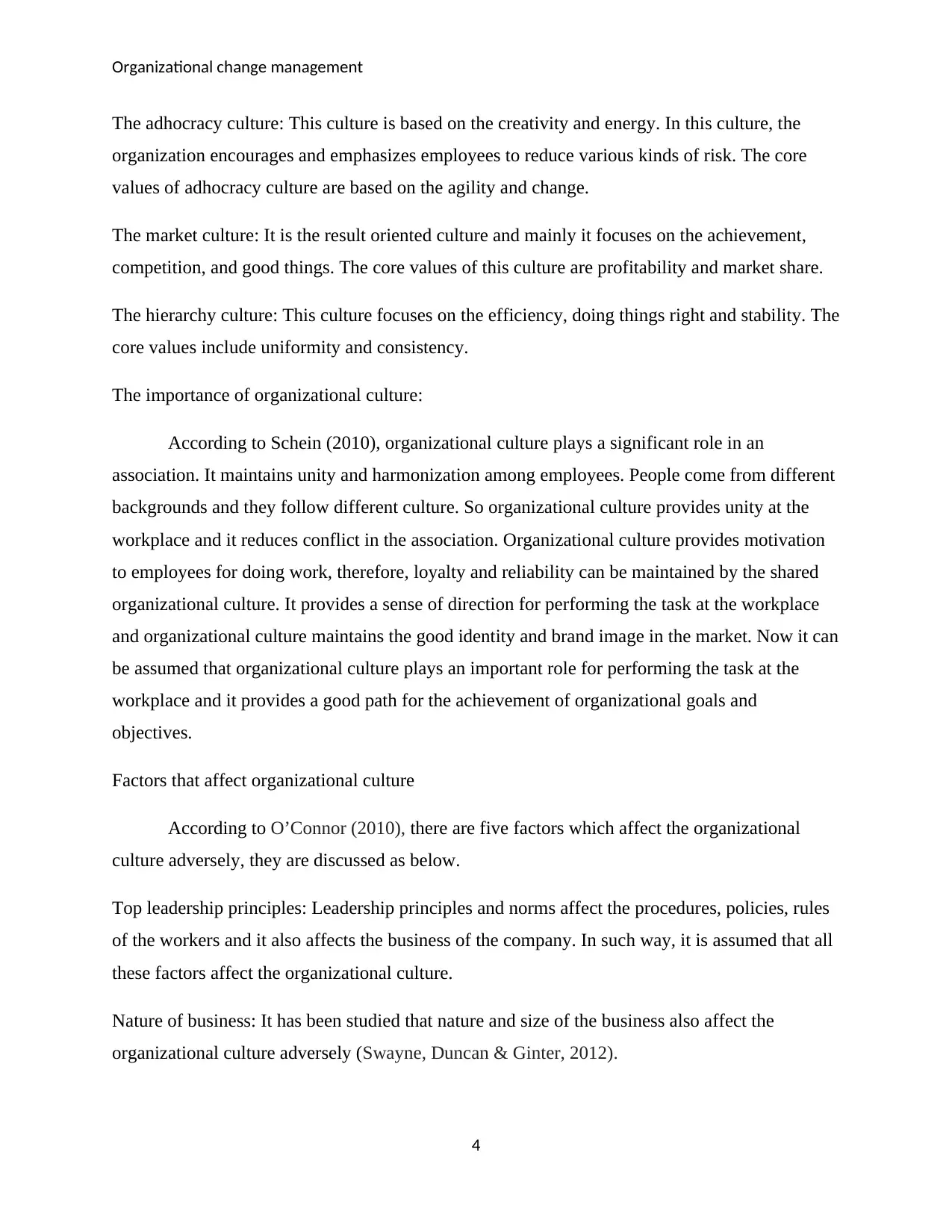
Organizational change management
The adhocracy culture: This culture is based on the creativity and energy. In this culture, the
organization encourages and emphasizes employees to reduce various kinds of risk. The core
values of adhocracy culture are based on the agility and change.
The market culture: It is the result oriented culture and mainly it focuses on the achievement,
competition, and good things. The core values of this culture are profitability and market share.
The hierarchy culture: This culture focuses on the efficiency, doing things right and stability. The
core values include uniformity and consistency.
The importance of organizational culture:
According to Schein (2010), organizational culture plays a significant role in an
association. It maintains unity and harmonization among employees. People come from different
backgrounds and they follow different culture. So organizational culture provides unity at the
workplace and it reduces conflict in the association. Organizational culture provides motivation
to employees for doing work, therefore, loyalty and reliability can be maintained by the shared
organizational culture. It provides a sense of direction for performing the task at the workplace
and organizational culture maintains the good identity and brand image in the market. Now it can
be assumed that organizational culture plays an important role for performing the task at the
workplace and it provides a good path for the achievement of organizational goals and
objectives.
Factors that affect organizational culture
According to O’Connor (2010), there are five factors which affect the organizational
culture adversely, they are discussed as below.
Top leadership principles: Leadership principles and norms affect the procedures, policies, rules
of the workers and it also affects the business of the company. In such way, it is assumed that all
these factors affect the organizational culture.
Nature of business: It has been studied that nature and size of the business also affect the
organizational culture adversely (Swayne, Duncan & Ginter, 2012).
4
The adhocracy culture: This culture is based on the creativity and energy. In this culture, the
organization encourages and emphasizes employees to reduce various kinds of risk. The core
values of adhocracy culture are based on the agility and change.
The market culture: It is the result oriented culture and mainly it focuses on the achievement,
competition, and good things. The core values of this culture are profitability and market share.
The hierarchy culture: This culture focuses on the efficiency, doing things right and stability. The
core values include uniformity and consistency.
The importance of organizational culture:
According to Schein (2010), organizational culture plays a significant role in an
association. It maintains unity and harmonization among employees. People come from different
backgrounds and they follow different culture. So organizational culture provides unity at the
workplace and it reduces conflict in the association. Organizational culture provides motivation
to employees for doing work, therefore, loyalty and reliability can be maintained by the shared
organizational culture. It provides a sense of direction for performing the task at the workplace
and organizational culture maintains the good identity and brand image in the market. Now it can
be assumed that organizational culture plays an important role for performing the task at the
workplace and it provides a good path for the achievement of organizational goals and
objectives.
Factors that affect organizational culture
According to O’Connor (2010), there are five factors which affect the organizational
culture adversely, they are discussed as below.
Top leadership principles: Leadership principles and norms affect the procedures, policies, rules
of the workers and it also affects the business of the company. In such way, it is assumed that all
these factors affect the organizational culture.
Nature of business: It has been studied that nature and size of the business also affect the
organizational culture adversely (Swayne, Duncan & Ginter, 2012).
4
Paraphrase This Document
Need a fresh take? Get an instant paraphrase of this document with our AI Paraphraser
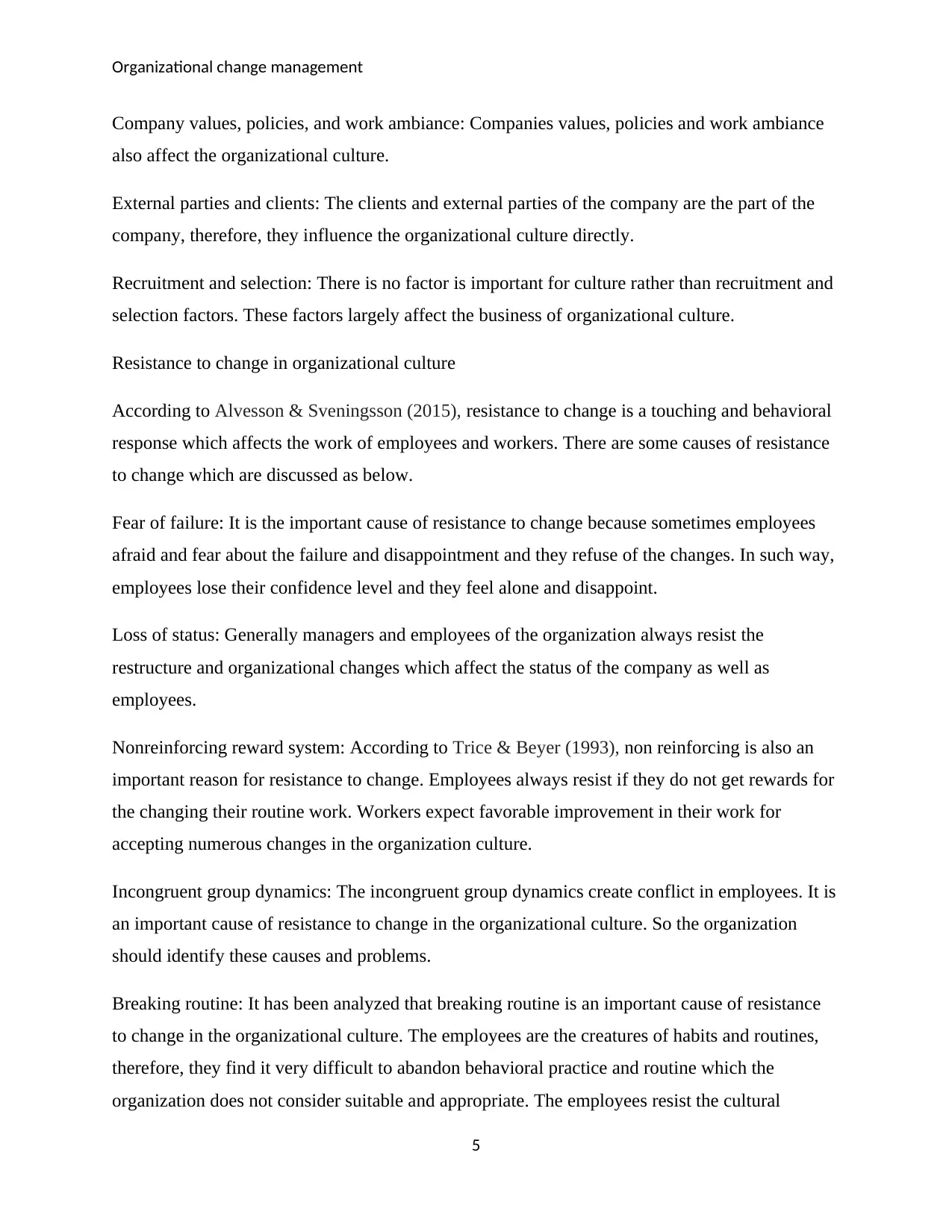
Organizational change management
Company values, policies, and work ambiance: Companies values, policies and work ambiance
also affect the organizational culture.
External parties and clients: The clients and external parties of the company are the part of the
company, therefore, they influence the organizational culture directly.
Recruitment and selection: There is no factor is important for culture rather than recruitment and
selection factors. These factors largely affect the business of organizational culture.
Resistance to change in organizational culture
According to Alvesson & Sveningsson (2015), resistance to change is a touching and behavioral
response which affects the work of employees and workers. There are some causes of resistance
to change which are discussed as below.
Fear of failure: It is the important cause of resistance to change because sometimes employees
afraid and fear about the failure and disappointment and they refuse of the changes. In such way,
employees lose their confidence level and they feel alone and disappoint.
Loss of status: Generally managers and employees of the organization always resist the
restructure and organizational changes which affect the status of the company as well as
employees.
Nonreinforcing reward system: According to Trice & Beyer (1993), non reinforcing is also an
important reason for resistance to change. Employees always resist if they do not get rewards for
the changing their routine work. Workers expect favorable improvement in their work for
accepting numerous changes in the organization culture.
Incongruent group dynamics: The incongruent group dynamics create conflict in employees. It is
an important cause of resistance to change in the organizational culture. So the organization
should identify these causes and problems.
Breaking routine: It has been analyzed that breaking routine is an important cause of resistance
to change in the organizational culture. The employees are the creatures of habits and routines,
therefore, they find it very difficult to abandon behavioral practice and routine which the
organization does not consider suitable and appropriate. The employees resist the cultural
5
Company values, policies, and work ambiance: Companies values, policies and work ambiance
also affect the organizational culture.
External parties and clients: The clients and external parties of the company are the part of the
company, therefore, they influence the organizational culture directly.
Recruitment and selection: There is no factor is important for culture rather than recruitment and
selection factors. These factors largely affect the business of organizational culture.
Resistance to change in organizational culture
According to Alvesson & Sveningsson (2015), resistance to change is a touching and behavioral
response which affects the work of employees and workers. There are some causes of resistance
to change which are discussed as below.
Fear of failure: It is the important cause of resistance to change because sometimes employees
afraid and fear about the failure and disappointment and they refuse of the changes. In such way,
employees lose their confidence level and they feel alone and disappoint.
Loss of status: Generally managers and employees of the organization always resist the
restructure and organizational changes which affect the status of the company as well as
employees.
Nonreinforcing reward system: According to Trice & Beyer (1993), non reinforcing is also an
important reason for resistance to change. Employees always resist if they do not get rewards for
the changing their routine work. Workers expect favorable improvement in their work for
accepting numerous changes in the organization culture.
Incongruent group dynamics: The incongruent group dynamics create conflict in employees. It is
an important cause of resistance to change in the organizational culture. So the organization
should identify these causes and problems.
Breaking routine: It has been analyzed that breaking routine is an important cause of resistance
to change in the organizational culture. The employees are the creatures of habits and routines,
therefore, they find it very difficult to abandon behavioral practice and routine which the
organization does not consider suitable and appropriate. The employees resist the cultural
5
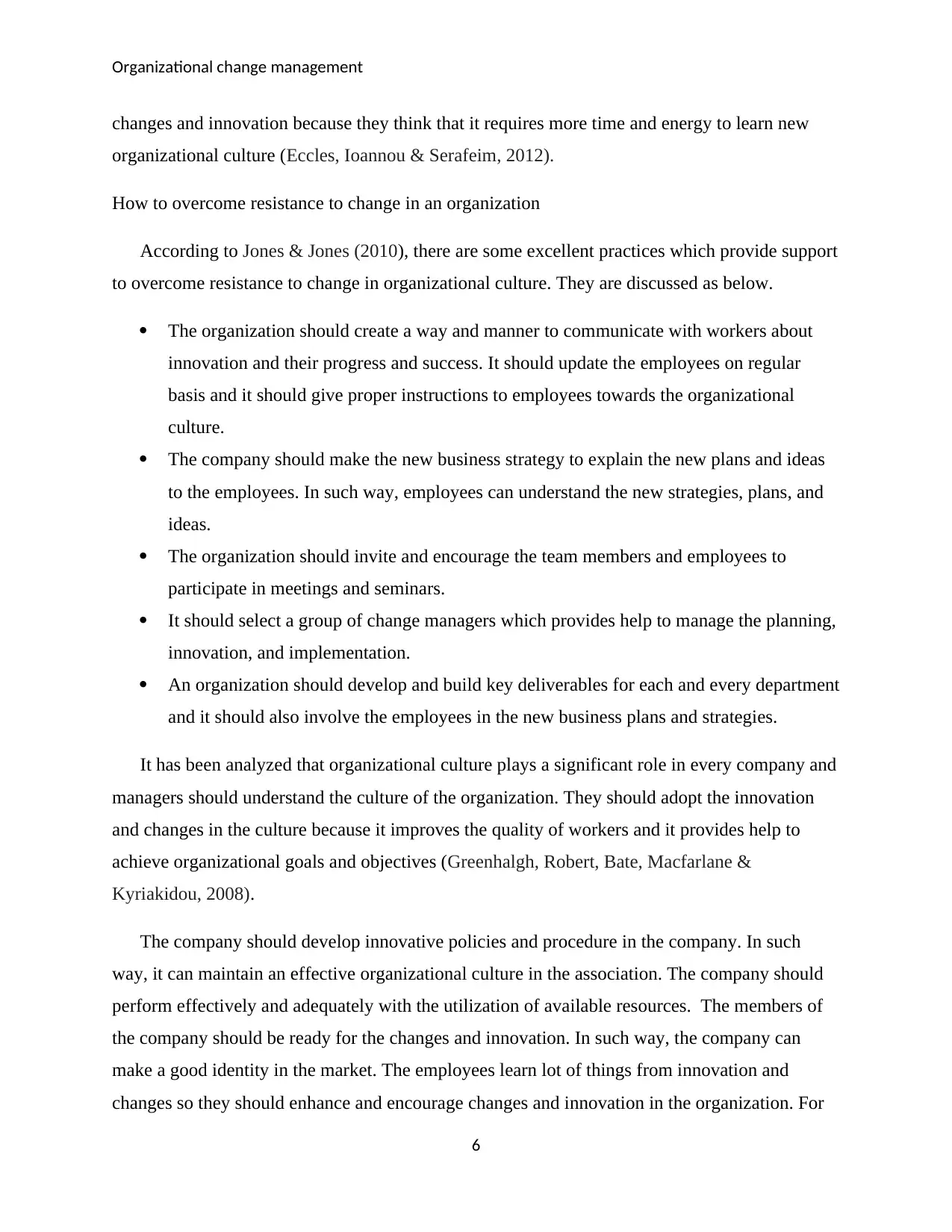
Organizational change management
changes and innovation because they think that it requires more time and energy to learn new
organizational culture (Eccles, Ioannou & Serafeim, 2012).
How to overcome resistance to change in an organization
According to Jones & Jones (2010), there are some excellent practices which provide support
to overcome resistance to change in organizational culture. They are discussed as below.
The organization should create a way and manner to communicate with workers about
innovation and their progress and success. It should update the employees on regular
basis and it should give proper instructions to employees towards the organizational
culture.
The company should make the new business strategy to explain the new plans and ideas
to the employees. In such way, employees can understand the new strategies, plans, and
ideas.
The organization should invite and encourage the team members and employees to
participate in meetings and seminars.
It should select a group of change managers which provides help to manage the planning,
innovation, and implementation.
An organization should develop and build key deliverables for each and every department
and it should also involve the employees in the new business plans and strategies.
It has been analyzed that organizational culture plays a significant role in every company and
managers should understand the culture of the organization. They should adopt the innovation
and changes in the culture because it improves the quality of workers and it provides help to
achieve organizational goals and objectives (Greenhalgh, Robert, Bate, Macfarlane &
Kyriakidou, 2008).
The company should develop innovative policies and procedure in the company. In such
way, it can maintain an effective organizational culture in the association. The company should
perform effectively and adequately with the utilization of available resources. The members of
the company should be ready for the changes and innovation. In such way, the company can
make a good identity in the market. The employees learn lot of things from innovation and
changes so they should enhance and encourage changes and innovation in the organization. For
6
changes and innovation because they think that it requires more time and energy to learn new
organizational culture (Eccles, Ioannou & Serafeim, 2012).
How to overcome resistance to change in an organization
According to Jones & Jones (2010), there are some excellent practices which provide support
to overcome resistance to change in organizational culture. They are discussed as below.
The organization should create a way and manner to communicate with workers about
innovation and their progress and success. It should update the employees on regular
basis and it should give proper instructions to employees towards the organizational
culture.
The company should make the new business strategy to explain the new plans and ideas
to the employees. In such way, employees can understand the new strategies, plans, and
ideas.
The organization should invite and encourage the team members and employees to
participate in meetings and seminars.
It should select a group of change managers which provides help to manage the planning,
innovation, and implementation.
An organization should develop and build key deliverables for each and every department
and it should also involve the employees in the new business plans and strategies.
It has been analyzed that organizational culture plays a significant role in every company and
managers should understand the culture of the organization. They should adopt the innovation
and changes in the culture because it improves the quality of workers and it provides help to
achieve organizational goals and objectives (Greenhalgh, Robert, Bate, Macfarlane &
Kyriakidou, 2008).
The company should develop innovative policies and procedure in the company. In such
way, it can maintain an effective organizational culture in the association. The company should
perform effectively and adequately with the utilization of available resources. The members of
the company should be ready for the changes and innovation. In such way, the company can
make a good identity in the market. The employees learn lot of things from innovation and
changes so they should enhance and encourage changes and innovation in the organization. For
6
⊘ This is a preview!⊘
Do you want full access?
Subscribe today to unlock all pages.

Trusted by 1+ million students worldwide
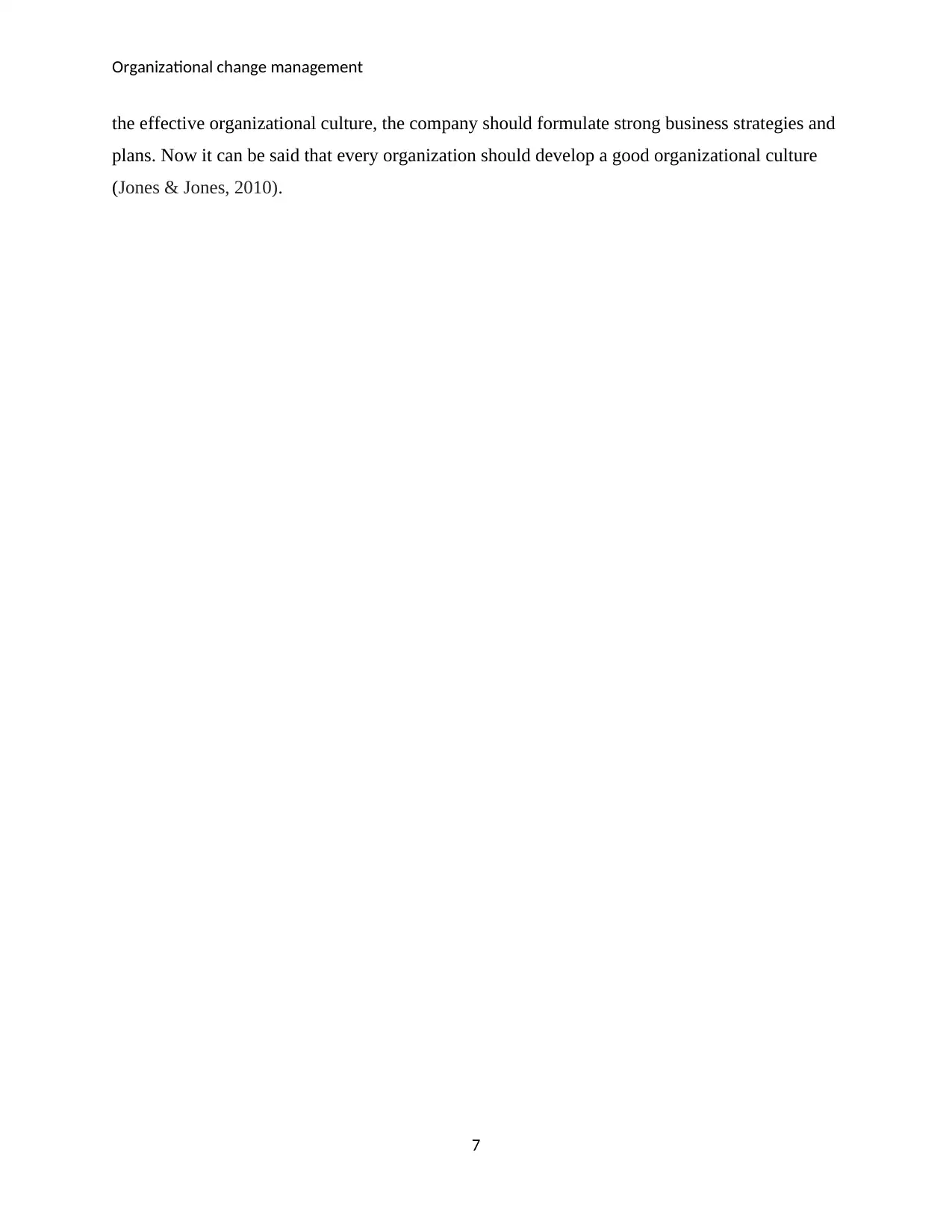
Organizational change management
the effective organizational culture, the company should formulate strong business strategies and
plans. Now it can be said that every organization should develop a good organizational culture
(Jones & Jones, 2010).
7
the effective organizational culture, the company should formulate strong business strategies and
plans. Now it can be said that every organization should develop a good organizational culture
(Jones & Jones, 2010).
7
Paraphrase This Document
Need a fresh take? Get an instant paraphrase of this document with our AI Paraphraser
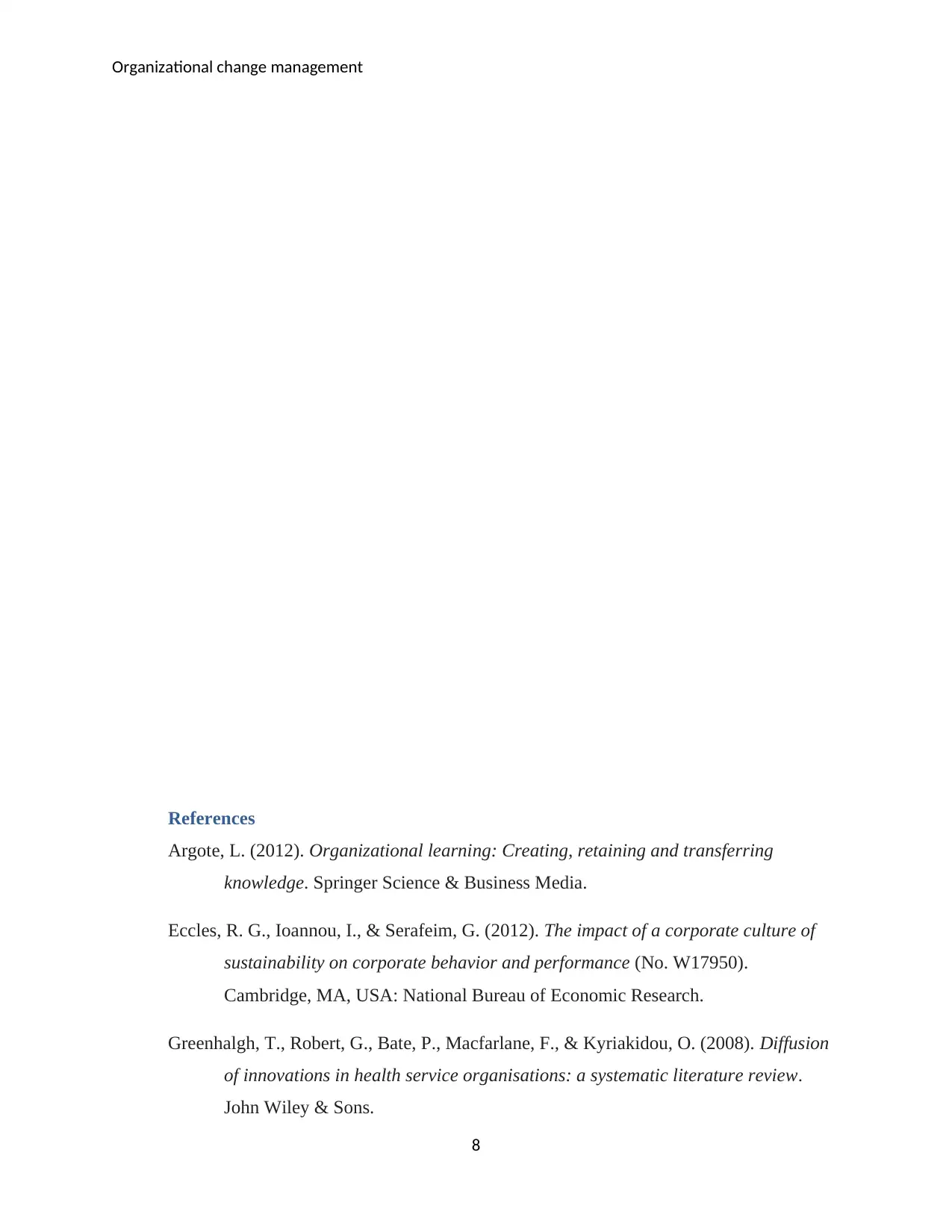
Organizational change management
References
Argote, L. (2012). Organizational learning: Creating, retaining and transferring
knowledge. Springer Science & Business Media.
Eccles, R. G., Ioannou, I., & Serafeim, G. (2012). The impact of a corporate culture of
sustainability on corporate behavior and performance (No. W17950).
Cambridge, MA, USA: National Bureau of Economic Research.
Greenhalgh, T., Robert, G., Bate, P., Macfarlane, F., & Kyriakidou, O. (2008). Diffusion
of innovations in health service organisations: a systematic literature review.
John Wiley & Sons.
8
References
Argote, L. (2012). Organizational learning: Creating, retaining and transferring
knowledge. Springer Science & Business Media.
Eccles, R. G., Ioannou, I., & Serafeim, G. (2012). The impact of a corporate culture of
sustainability on corporate behavior and performance (No. W17950).
Cambridge, MA, USA: National Bureau of Economic Research.
Greenhalgh, T., Robert, G., Bate, P., Macfarlane, F., & Kyriakidou, O. (2008). Diffusion
of innovations in health service organisations: a systematic literature review.
John Wiley & Sons.
8
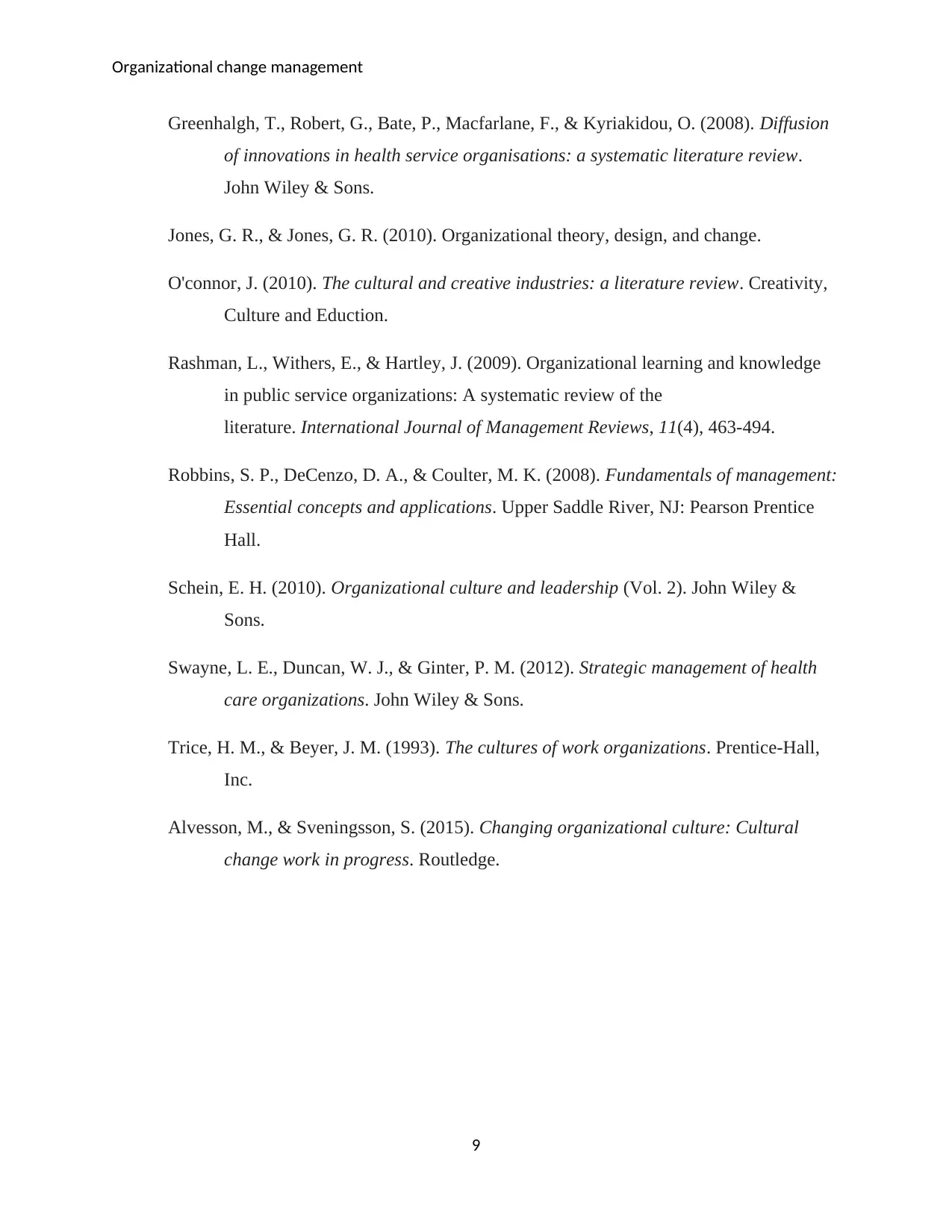
Organizational change management
Greenhalgh, T., Robert, G., Bate, P., Macfarlane, F., & Kyriakidou, O. (2008). Diffusion
of innovations in health service organisations: a systematic literature review.
John Wiley & Sons.
Jones, G. R., & Jones, G. R. (2010). Organizational theory, design, and change.
O'connor, J. (2010). The cultural and creative industries: a literature review. Creativity,
Culture and Eduction.
Rashman, L., Withers, E., & Hartley, J. (2009). Organizational learning and knowledge
in public service organizations: A systematic review of the
literature. International Journal of Management Reviews, 11(4), 463-494.
Robbins, S. P., DeCenzo, D. A., & Coulter, M. K. (2008). Fundamentals of management:
Essential concepts and applications. Upper Saddle River, NJ: Pearson Prentice
Hall.
Schein, E. H. (2010). Organizational culture and leadership (Vol. 2). John Wiley &
Sons.
Swayne, L. E., Duncan, W. J., & Ginter, P. M. (2012). Strategic management of health
care organizations. John Wiley & Sons.
Trice, H. M., & Beyer, J. M. (1993). The cultures of work organizations. Prentice-Hall,
Inc.
Alvesson, M., & Sveningsson, S. (2015). Changing organizational culture: Cultural
change work in progress. Routledge.
9
Greenhalgh, T., Robert, G., Bate, P., Macfarlane, F., & Kyriakidou, O. (2008). Diffusion
of innovations in health service organisations: a systematic literature review.
John Wiley & Sons.
Jones, G. R., & Jones, G. R. (2010). Organizational theory, design, and change.
O'connor, J. (2010). The cultural and creative industries: a literature review. Creativity,
Culture and Eduction.
Rashman, L., Withers, E., & Hartley, J. (2009). Organizational learning and knowledge
in public service organizations: A systematic review of the
literature. International Journal of Management Reviews, 11(4), 463-494.
Robbins, S. P., DeCenzo, D. A., & Coulter, M. K. (2008). Fundamentals of management:
Essential concepts and applications. Upper Saddle River, NJ: Pearson Prentice
Hall.
Schein, E. H. (2010). Organizational culture and leadership (Vol. 2). John Wiley &
Sons.
Swayne, L. E., Duncan, W. J., & Ginter, P. M. (2012). Strategic management of health
care organizations. John Wiley & Sons.
Trice, H. M., & Beyer, J. M. (1993). The cultures of work organizations. Prentice-Hall,
Inc.
Alvesson, M., & Sveningsson, S. (2015). Changing organizational culture: Cultural
change work in progress. Routledge.
9
⊘ This is a preview!⊘
Do you want full access?
Subscribe today to unlock all pages.

Trusted by 1+ million students worldwide
1 out of 9
Related Documents
Your All-in-One AI-Powered Toolkit for Academic Success.
+13062052269
info@desklib.com
Available 24*7 on WhatsApp / Email
![[object Object]](/_next/static/media/star-bottom.7253800d.svg)
Unlock your academic potential
Copyright © 2020–2025 A2Z Services. All Rights Reserved. Developed and managed by ZUCOL.





